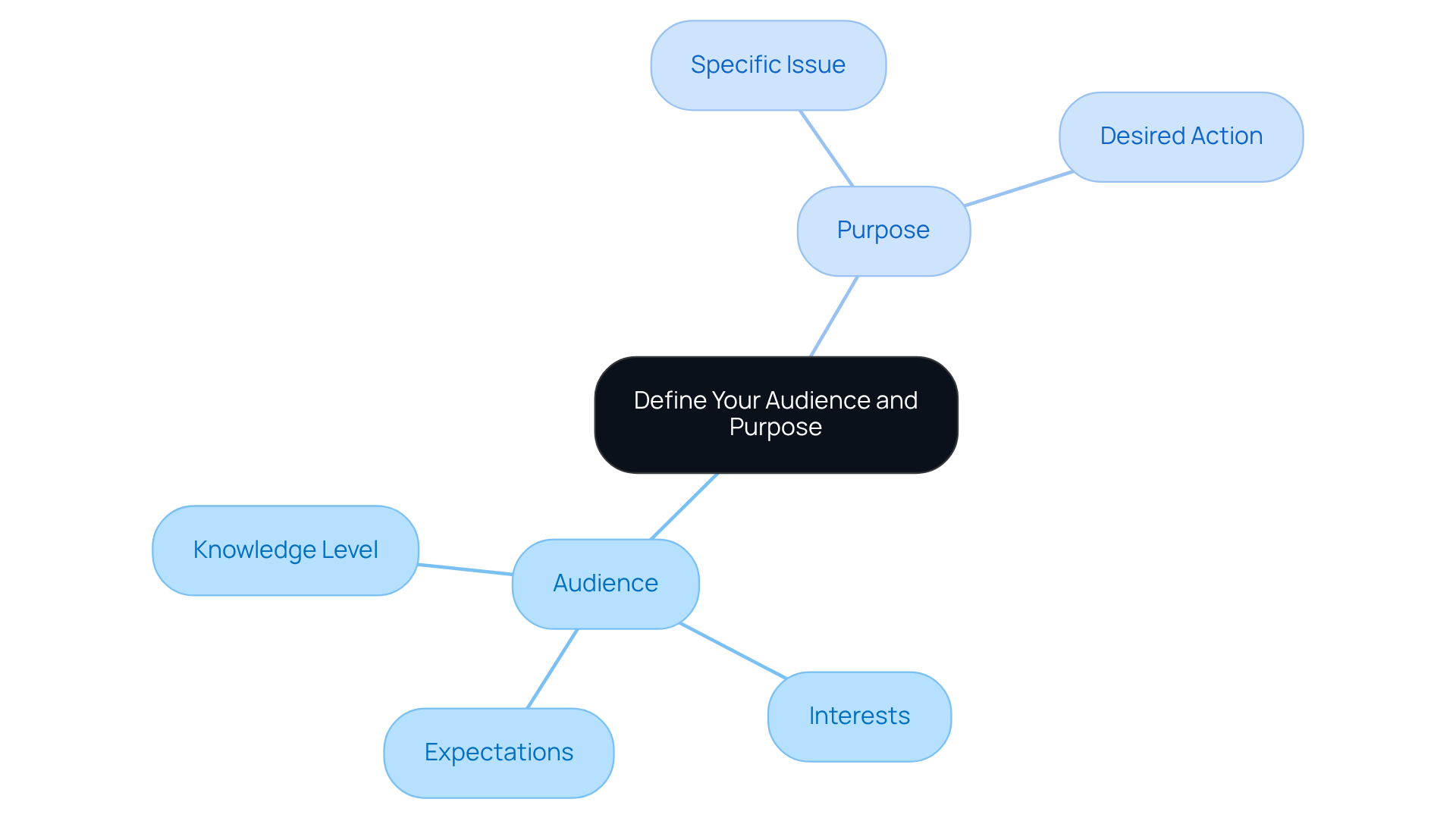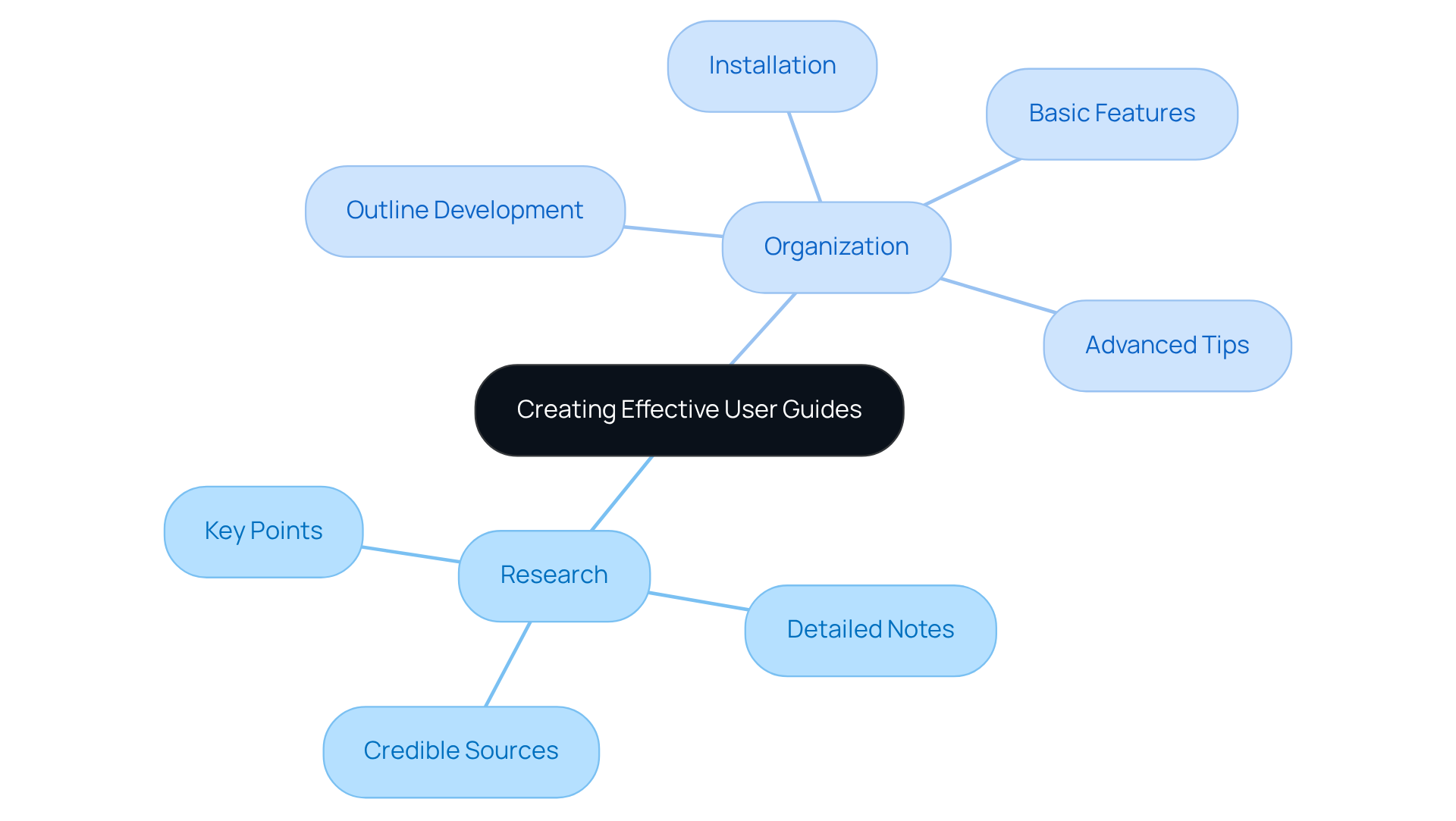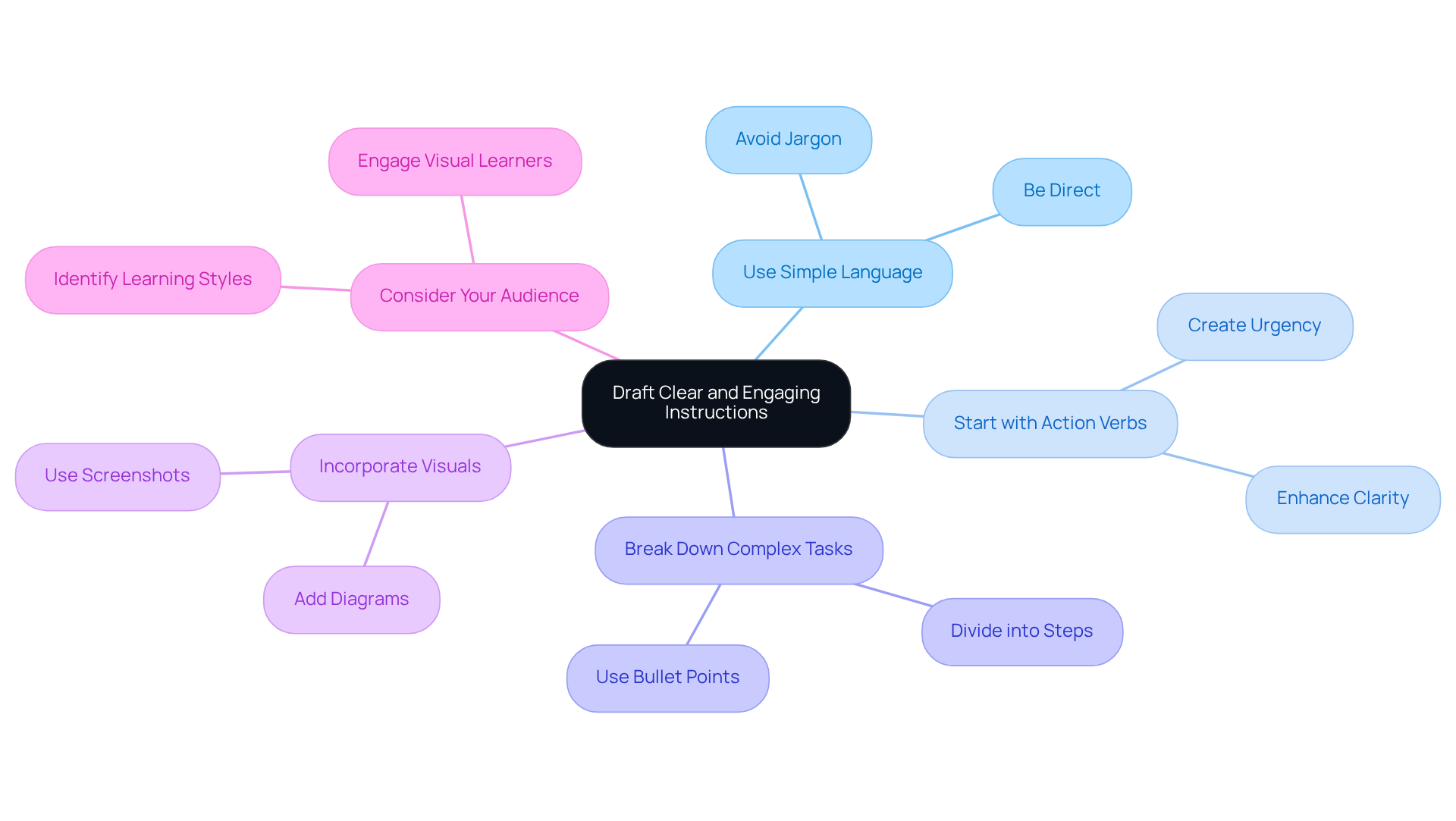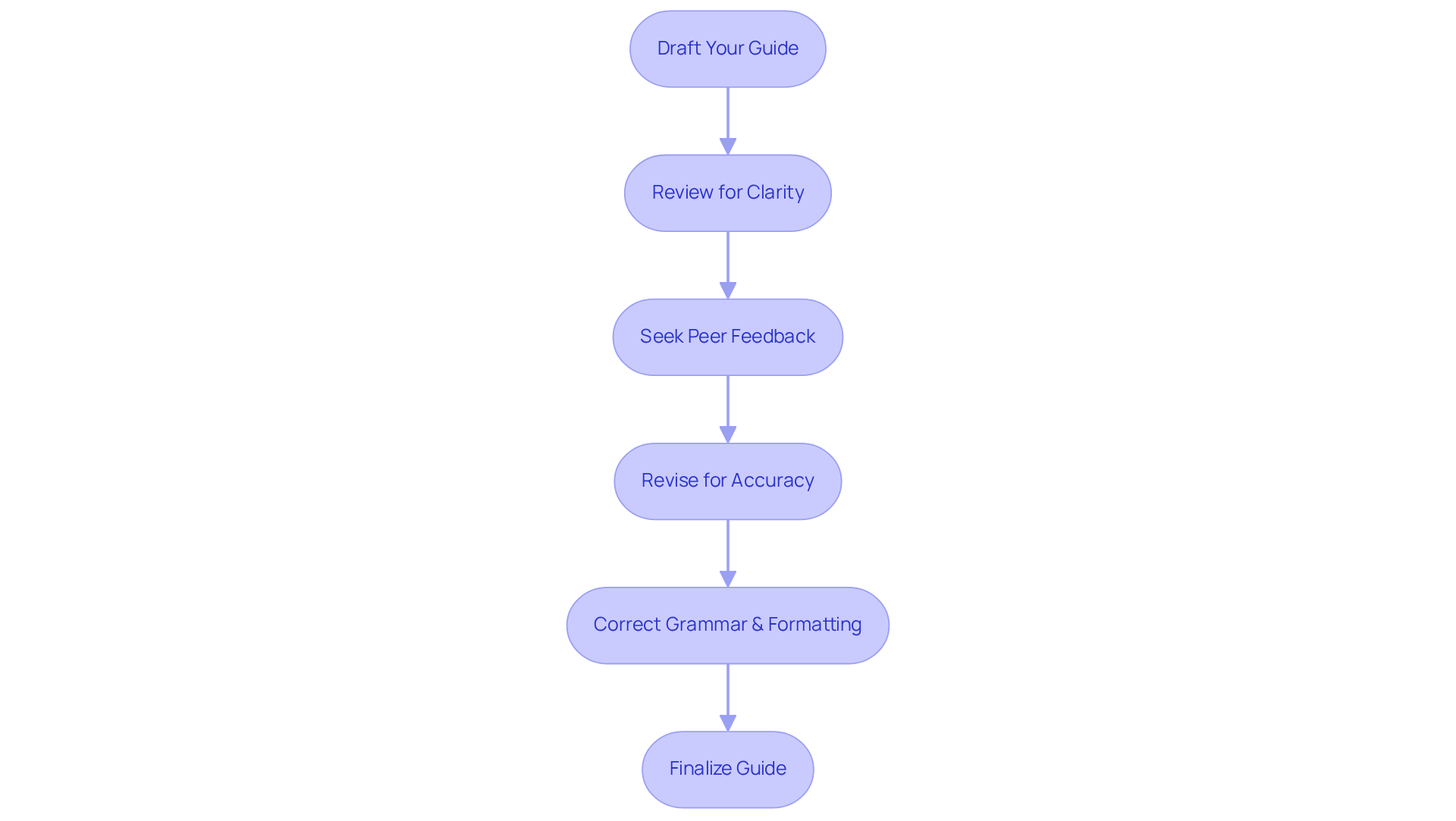
Overview
So, you’re looking to create an effective guide? First things first: you need to figure out who your target audience is and what the guide’s purpose will be. Once you’ve got that down, dive into some thorough research and whip up a structured outline.
Now, here’s the kicker: to really make your guide shine, you want to:
- Include clear and engaging instructions
- Sprinkle in some visuals
- Regularly review and update the content
This is key to keeping your readers engaged and ensuring your guide stays relevant!
Key Highlights:
- Identify the target audience by considering their knowledge level and interests to tailor the content appropriately.
- Clarify the purpose of the guide by determining the specific issue it addresses and the desired action for readers.
- Conduct thorough research using credible sources to gather relevant information and take detailed notes.
- Organise the content into a structured outline with clear sections and subsections to enhance logical flow.
- Draught instructions using simple language, action verbs, and break complex tasks into manageable steps.
- Incorporate visuals like screenshots and diagrams to improve comprehension and engagement.
- Review and revise the guide for clarity, coherence, and accuracy, considering peer feedback to enhance effectiveness.
- Publish the guide through accessible channels and establish a schedule for regular updates and user feedback to maintain relevance.
Introduction
Creating effective documentation is a skill that can really change how information is shared and understood. You might be wondering how mastering the art of guide-making can help you ensure your content resonates with your audience while meeting their specific needs. But here’s the kicker: it’s all about finding that sweet spot between clarity and engagement.
How do you craft instructions that are not just informative but also captivating? In this article, we’ll dive into the essential steps for creating a guide—from defining your audience and purpose to organizing your content and ensuring accuracy—all while keeping the reader's experience front and center.
Define Your Audience and Purpose
To kick off your guide effectively, you might be wondering how to make a guide, and it all begins with identifying your intended group. Think about their knowledge level, interests, and what they hope to achieve by diving into your content. For example, if your listeners are beginners, it's super important to steer clear of jargon and provide thorough explanations. On the flip side, if your audience is more seasoned, feel free to sprinkle in some technical language and assume they've got a foundational grasp of the topic.
Now, let’s dive into the purpose of your manual. Reflect on questions like:
- What specific issue does this manual tackle?
- What action do I want the reader to take after they’ve read it?
Getting this clarity down will not only streamline your content creation process but also ensure that your guide on how to make a guide stays focused and relevant throughout. Remember, 68 percent of consumers expect all experiences to be tailored, which really highlights the importance of demographic analysis in documentation. As Sunil Gupta wisely points out, "Selecting the appropriate target group can yield benefits for your digital marketing strategy." And don’t forget, using tools like audience surveys or analytics can really help you pinpoint what your target audience needs.

Research and Organize Your Content
To understand how to make a guide, creating effective user guides starts with some solid research on your topic. You might be wondering where to begin—well, look for credible sources like articles, books, and expert insights to gather all the relevant info you need. As you dig into your findings, be sure to take detailed notes on key points, examples, and supporting data that will really boost your instructions.
Once you’ve wrapped up your research, it’s time to get organized! Think about developing an outline that breaks down the information into clear sections and subsections. This outline will serve as your roadmap, guiding your manual and ensuring a logical flow from one part to the next. For instance, if your manual is about a software tool, you might want to structure it into sections like:
- Installation
- Basic Features
- Advanced Tips
Did you know that well-organized content can significantly enhance user comprehension and retention? It’s true! By prioritizing a structured approach, you’re not just improving the usability of your guides; you’re also learning how to make a guide that enhances the learning experience for your audience. So, let’s dive into this process together and make those user guides shine!

Draft Clear and Engaging Instructions
When you're drafting your instructions, it’s all about clarity and engagement! You might be wondering how to make a guide to achieve that—well, start with simple, direct language. Kick off each step with an action verb to create a sense of urgency and precision. For example, instead of saying 'You should open the application,' just say 'Open the application.' It’s straightforward, right? Break down complex tasks into smaller, manageable steps to keep from overwhelming your readers. Using bullet points or numbered lists can really help with readability, too.
Now, let’s talk visuals! Incorporating things like screenshots or diagrams can make a world of difference in comprehension and keep your readers interested. Did you know that research from 3M shows visuals can boost learning by up to 400%? That’s huge! So, when you’re explaining how to navigate a software interface, consider adding annotated screenshots that highlight the relevant buttons or features. This not only clarifies your instructions but also caters to the 65% of learners who are visual learners.
Michelle Connolly points out that traditional education often misses the mark for visual learners, which is why integrating visuals is so important. By using these strategies, you can learn how to make a guide that is not just engaging but also effective, promoting better understanding and retention. So, why not give it a try?

Review and Revise for Clarity and Accuracy
Once you've drafted your guide, you might be wondering how to make a guide for what comes next. It's super important to dive into a thorough review and revision process. Read through your content a few times, keeping an eye out for clarity, coherence, and accuracy. Have you thought about asking your coworkers or specialists for their input? Research shows that peer reviews can boost accuracy and effectiveness by up to 40%! So, don’t skip this step!
Pay close attention to any sections that might be confusing or unclear—those are the ones you’ll want to revise for better understanding. And let’s not forget about grammar! Make sure those pesky errors are corrected and that your formatting is consistent throughout the document. A well-reviewed manual on how to make a guide not only enhances readability but also strengthens the credibility of the information you're sharing, making it a valuable resource for users.
Now, speaking of making things easier, have you heard about SowFlow? It streamlines the review and revision process. Users like Anastasia Masadi have found that it helps them create SOPs and training materials efficiently, without the hassle of taking separate screenshots or leaving their browser. By using SowFlow's features, you can enhance your documentation process, crafting high-quality resources that truly meet your team's needs.

Publish and Update Your Guide Regularly
Once you understand how to make a guide, it’s time to share it through the right channels—maybe your company intranet, a website, or a documentation platform. You want to make sure it’s super easy for your audience to find. After you hit that publish button, don’t forget to set up a schedule for regular reviews and updates. Whether it’s quarterly or bi-annually, it depends on what your content needs. During these check-ins, take a moment to look for any changes in processes, tools, or best practices that might affect your document.
And hey, encourage user feedback! It’s a great way to spot areas that could use some improvement and helps you understand how to make a guide that meets the needs of its audience. Keeping your documentation fresh not only boosts its value but also helps create a culture of continuous improvement in your organization.

Conclusion
Creating an effective guide is a multifaceted process that really hinges on understanding your audience and purpose. You might be wondering, what does that mean for me? Well, it’s all about conducting thorough research, drafting clear instructions, and keeping the document fresh over time. By focusing on these key elements, anyone can produce documentation that not only informs but also engages and empowers users to take action.
Throughout the article, we highlighted essential steps, like:
- Defining your target audience to tailor content effectively.
- Organizing information logically to enhance comprehension.
- Utilizing visuals to boost engagement.
- Implementing a rigorous review process and regular updates to ensure that your guide remains accurate and relevant.
In conclusion, the art of guide creation isn’t just about sharing information; it’s about crafting a resource that truly resonates with users and meets their needs. By implementing the strategies we discussed, you and your organization can develop documentation that stands the test of time, providing lasting value. So, why not embrace these practices to elevate your guide-making skills and contribute to a more informed and capable audience?
Frequently Asked Questions
How do I define my audience when creating a guide?
To define your audience, consider their knowledge level, interests, and what they hope to achieve from your content. Tailor your language and explanations based on whether your audience consists of beginners or seasoned individuals.
What should I consider regarding the purpose of my guide?
Reflect on the specific issue your guide addresses and the action you want readers to take after reading it. This clarity will help keep your content focused and relevant.
Why is demographic analysis important in creating a guide?
Demographic analysis helps tailor experiences to meet consumer expectations. It ensures that your guide is relevant to your target audience, which can enhance your overall strategy.
What sources should I use for research when making a guide?
Look for credible sources such as articles, books, and expert insights to gather relevant information. Taking detailed notes on key points and supporting data will strengthen your guide.
How should I organize my content after researching?
Develop an outline that breaks down the information into clear sections and subsections. This structured approach will serve as a roadmap, ensuring a logical flow of information throughout your guide.
What is an example structure for a software tool manual?
An example structure could include sections like Installation, Basic Features, and Advanced Tips, which helps users navigate the content effectively.
How does organization impact user comprehension?
Well-organized content significantly enhances user comprehension and retention by improving usability and creating a better learning experience for the audience.
👍
What others are liking
5 Steps to outline your ideal documentation structure
5 MINS READ
Where to start the your journey of mapping out your ideal documentation structure, aligning it with the very heartbeat of your organization?
Defining a winning level of detail in your process
3 MINS READ
What is too much detail, and what is too little? This article described in that winning level detail about what detail is enough.





